PEP六年级英语上册第一单元导学案
- 格式:doc
- 大小:1.14 MB
- 文档页数:16
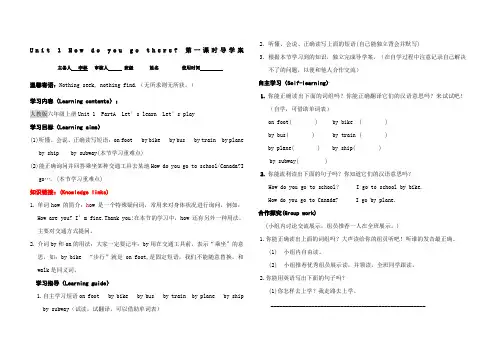
U n i t1H o w d o y o u g o t h e r e?第一课时导学案主备人李林审核人班级姓名使用时间温馨寄语:Nothing seek, nothing find.(无所求则无所获。
)学习内容(Learning contents):人教版六年级上册Unit 1 PartA Let’s learn Let’s play学习目标(Learning aims)(1)听懂、会说、正确读写短语:on foot by bike by bus by train by planeby ship by subway(本节学习重难点)(2)能正确询问并回答乘坐某种交通工具去某地How do you go to school/Canada?Igo…. (本节学习重难点)知识链接:(Knowledge links)1.单词how 的简介:h ow 是一个特殊疑问词,常用来对身体状况进行询问,例如:How are you? I’m fine.Thank you!在本节的学习中,how 还有另外一种用法,主要对交通方式提问。
2.介词by和on的用法:大家一定要记牢:by用在交通工具前,表示“乘坐”的意思,如:by bike “步行”就是on foot,是固定短语,我们不能随意替换,和walk是同义词。
学习指导(Learning guide)1.自主学习短语on foot by bike by bus by train by plane by shipby subway(试读,试翻译,可以借助单词表)2. 听懂、会说、正确读写上面的短语(自己能独立背会并默写)3. 根据本节学习到的知识,独立完成导学案。
(在自学过程中注意记录自己解决不了的问题,以便和他人合作交流)自主学习(Self-learning)1.你能正确读出下面的词组吗?你能正确翻译它们的汉语意思吗?来试试吧!(自学,可借助单词表)on foot( ) by bike ( )by bus( ) by train ( )by plane( ) by ship( )by subway( )2.你能流利读出下面的句子吗?你知道它们的汉语意思吗?How do you go to school? I go to school by bike.How do you go to Canada? I go by plane.合作探究(Group work)(小组内讨论交流展示,组员推荐一人在全班展示。
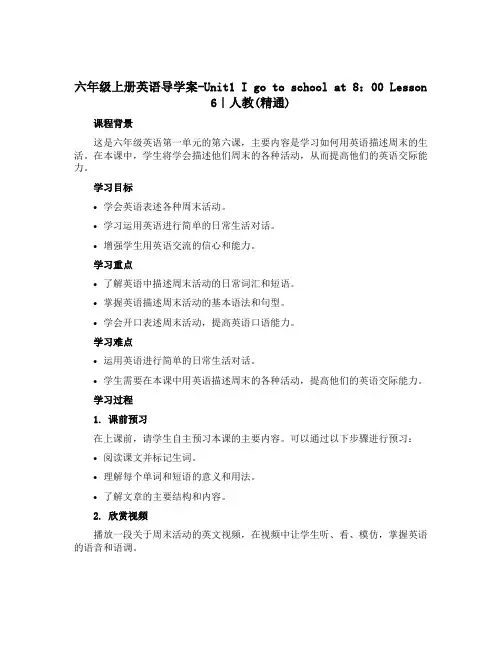
六年级上册英语导学案-Unit1 I go to school at 8:00 Lesson6|人教(精通)课程背景这是六年级英语第一单元的第六课,主要内容是学习如何用英语描述周末的生活。
在本课中,学生将学会描述他们周末的各种活动,从而提高他们的英语交际能力。
学习目标•学会英语表述各种周末活动。
•学习运用英语进行简单的日常生活对话。
•增强学生用英语交流的信心和能力。
学习重点•了解英语中描述周末活动的日常词汇和短语。
•掌握英语描述周末活动的基本语法和句型。
•学会开口表述周末活动,提高英语口语能力。
学习难点•运用英语进行简单的日常生活对话。
•学生需要在本课中用英语描述周末的各种活动,提高他们的英语交际能力。
学习过程1. 课前预习在上课前,请学生自主预习本课的主要内容。
可以通过以下步骤进行预习:•阅读课文并标记生词。
•理解每个单词和短语的意义和用法。
•了解文章的主要结构和内容。
2. 欣赏视频播放一段关于周末活动的英文视频,在视频中让学生听、看、模仿,掌握英语的语音和语调。
3. 听力训练在听力训练环节,播放本课的录音材料,让学生跟读并模仿录音中的语音和语调,从而加深对单词和短语的理解。
4. 交际演练在交际演练环节,学生可以交流自己在周末的活动。
老师可以引导学生提高语感,让学生逐渐掌握英语口语交流的技巧和方法。
5. 语法讲解在语法讲解环节,老师可以通过知识点讲解、例句分析等方式,帮助学生理解本课的语法和句型。
在这里,老师可以训练学生的英语思维和表达能力,让学生更加熟练并自如地运用英语。
6. 课后作业在课后作业环节,老师可以布置一些练习题和作业,帮助学生巩固本课内容,如通过填空题、选择题、阅读理解等方式测试学生的掌握情况。
学习评估在学习过程中,老师可以通过听、说、读、写等方式对学生的英语水平和英语能力进行评估,从而更好地指导后续的教学。
总结在本课中,学生将学会描述他们周末的各种活动,从而提高他们的英语交际能力。
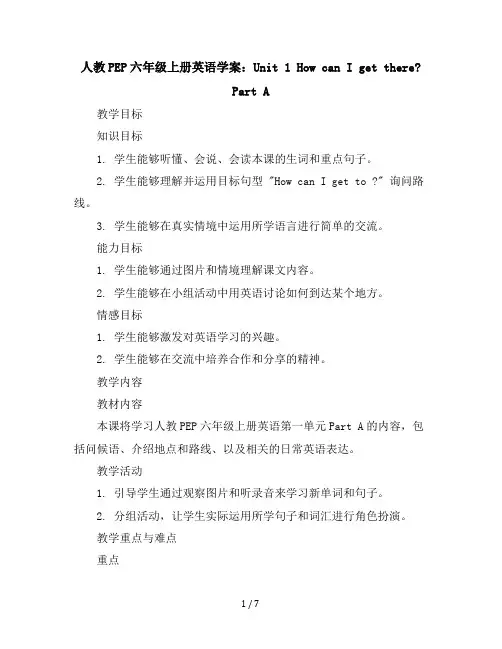
人教PEP六年级上册英语学案:Unit 1 How can I get there?Part A教学目标知识目标1. 学生能够听懂、会说、会读本课的生词和重点句子。
2. 学生能够理解并运用目标句型 "How can I get to ?" 询问路线。
3. 学生能够在真实情境中运用所学语言进行简单的交流。
能力目标1. 学生能够通过图片和情境理解课文内容。
2. 学生能够在小组活动中用英语讨论如何到达某个地方。
情感目标1. 学生能够激发对英语学习的兴趣。
2. 学生能够在交流中培养合作和分享的精神。
教学内容教材内容本课将学习人教PEP六年级上册英语第一单元Part A的内容,包括问候语、介绍地点和路线、以及相关的日常英语表达。
教学活动1. 引导学生通过观察图片和听录音来学习新单词和句子。
2. 分组活动,让学生实际运用所学句子和词汇进行角色扮演。
教学重点与难点重点1. 掌握本课的生词和关键句子。
2. 能够运用目标句型询问和描述路线。
难点1. 对不熟悉的地名和地点的正确发音。
2. 在实际情境中灵活运用英语进行路线描述。
教具与学具准备教具1. 课文插图和相关的地点图片。
2. 录音机或多媒体设备用于播放听力材料。
3. 教学卡片或黑板用于板书关键词和句子。
学具1. 课本和相关练习册。
2. 彩色笔用于标记和记忆重点内容。
教学过程导入(5分钟)1. 利用图片和简单的问候语与学生进行日常交流,营造轻松的英语氛围。
2. 通过提问学生熟悉的地点和路线,激发学生对学习内容的兴趣。
展示(15分钟)1. 播放课文听力材料,让学生整体感知和理解对话内容。
2. 分组讨论,让学生模仿和重复重点句子。
实践(10分钟)1. 分角色扮演,让学生在小组内用英语进行路线描述和角色扮演活动。
2. 提供一些地点和情境,让学生实际运用所学句子进行交流。
巩固(10分钟)1. 通过填空、匹配或问答等练习,检测学生对单词和句子的掌握情况。
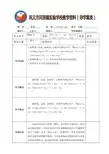
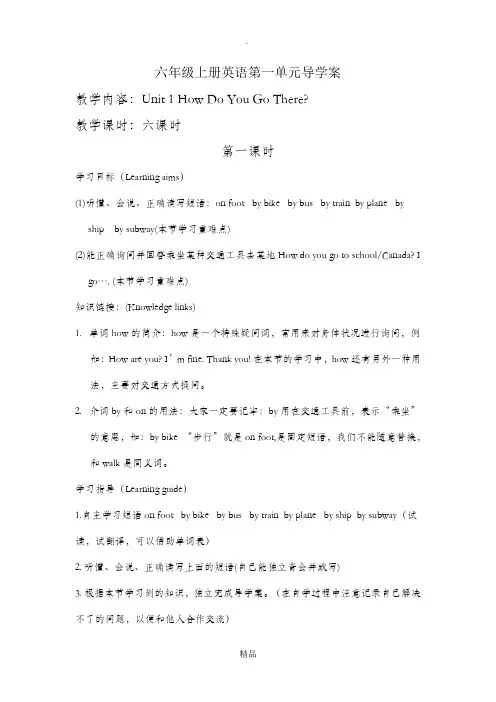
六年级上册英语第一单元导学案教学内容:Unit 1 How Do You Go There?教学课时:六课时第一课时学习目标(Learning aims)(1)听懂、会说、正确读写短语:on foot by bike by bus by train by plane byship by subway(本节学习重难点)(2)能正确询问并回答乘坐某种交通工具去某地How do you go to school/Canada? Igo…. (本节学习重难点)知识链接:(Knowledge links)1.单词how 的简介:how 是一个特殊疑问词,常用来对身体状况进行询问,例如:How are you? I’m fine. Thank you! 在本节的学习中,how 还有另外一种用法,主要对交通方式提问。
2.介词by和on的用法:大家一定要记牢:by用在交通工具前,表示“乘坐”的意思,如:by bike “步行”就是on foot,是固定短语,我们不能随意替换,和walk是同义词。
学习指导(Learning guide)1.自主学习短语on foot by bike by bus by train by plane by ship by subway(试读,试翻译,可以借助单词表)2. 听懂、会说、正确读写上面的短语(自己能独立背会并默写)3. 根据本节学习到的知识,独立完成导学案。
(在自学过程中注意记录自己解决不了的问题,以便和他人合作交流)自主学习(Self-learning)1、你能正确读出下面的词组吗?你能正确翻译它们的汉语意思吗?来试试吧!(自学,可借助单词表)on foot( ) by bike ( )by bus( ) by train ( )by plane( ) by ship( )by subway( )2、你能流利读出下面的句子吗?你知道它们的汉语意思吗?How do you go to school? I go to school by bike.How do you go to Canada? I go by plane.合作探究(Group work)(小组内讨论交流展示,组员推荐一人在全班展示。
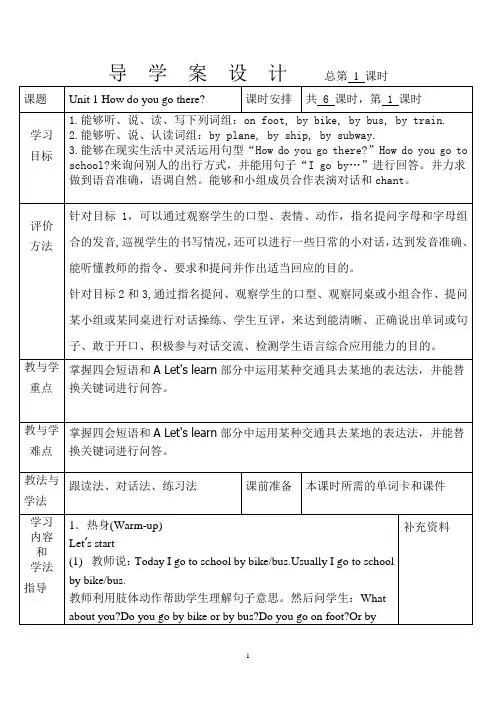
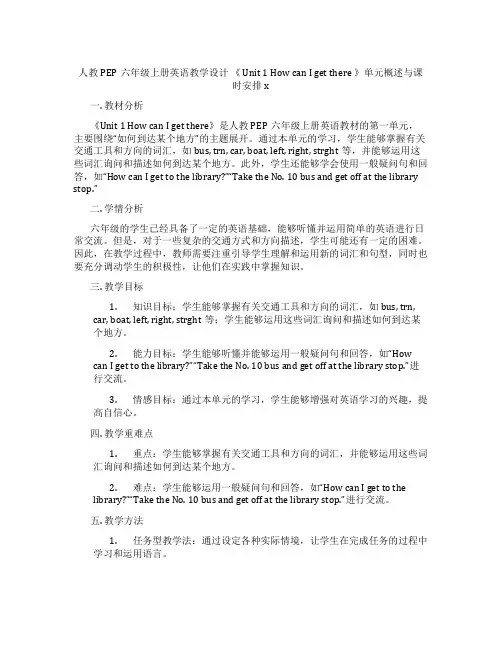
人教PEP六年级上册英语教学设计《 Unit 1 How can I get there 》单元概述与课时安排x一. 教材分析《Unit 1 How can I get there》是人教PEP六年级上册英语教材的第一单元,主要围绕“如何到达某个地方”的主题展开。
通过本单元的学习,学生能够掌握有关交通工具和方向的词汇,如bus, trn, car, boat, left, right, strght等,并能够运用这些词汇询问和描述如何到达某个地方。
此外,学生还能够学会使用一般疑问句和回答,如“How can I get to the library?”“Take the No. 10 bus and get off at the library stop.”二. 学情分析六年级的学生已经具备了一定的英语基础,能够听懂并运用简单的英语进行日常交流。
但是,对于一些复杂的交通方式和方向描述,学生可能还有一定的困难。
因此,在教学过程中,教师需要注重引导学生理解和运用新的词汇和句型,同时也要充分调动学生的积极性,让他们在实践中掌握知识。
三. 教学目标1.知识目标:学生能够掌握有关交通工具和方向的词汇,如bus, trn,car, boat, left, right, strght等;学生能够运用这些词汇询问和描述如何到达某个地方。
2.能力目标:学生能够听懂并能够运用一般疑问句和回答,如“Howcan I get to the library?”“Take the No.10 bus and get off at the library stop.”进行交流。
3.情感目标:通过本单元的学习,学生能够增强对英语学习的兴趣,提高自信心。
四. 教学重难点1.重点:学生能够掌握有关交通工具和方向的词汇,并能够运用这些词汇询问和描述如何到达某个地方。
2.难点:学生能够运用一般疑问句和回答,如“How can I get to thelibrary?”“Take the No.10 bus and get off at the library stop.”进行交流。
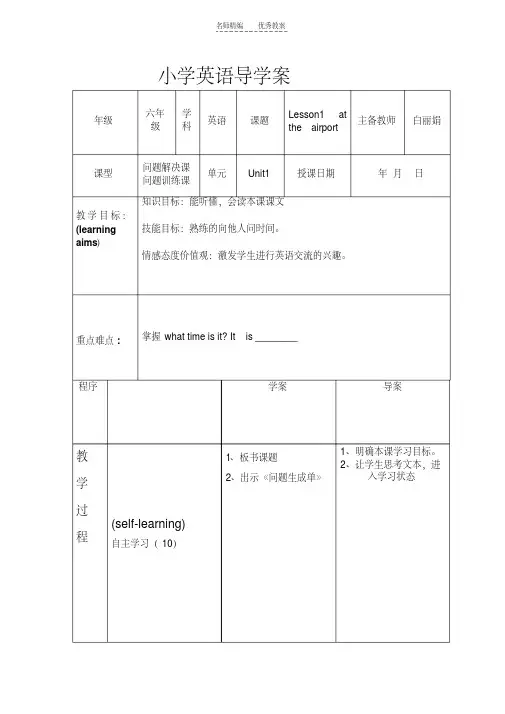
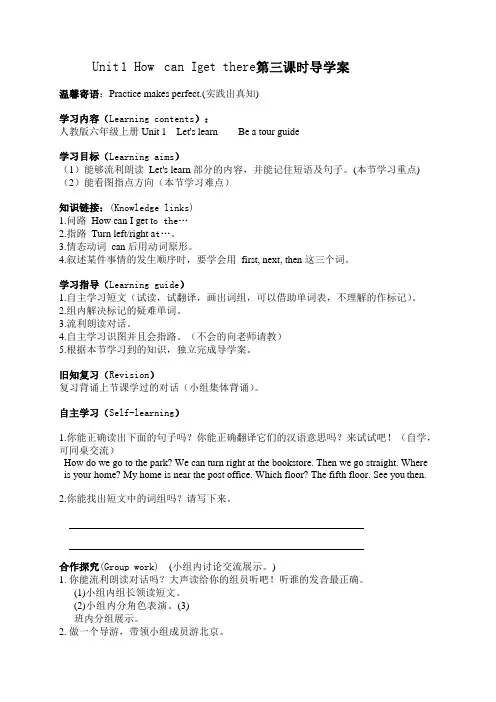
Unit 1 How can Iget there第?三课时导学案温馨寄语:Practice makes perfect.(实践出真知)学习内容(Learning contents):人教版六年级上册Unit 1 Let's learn Be a tour guide学习目标(Learning aims)(1)能够流利朗读Let's learn 部分的内容,并能记住短语及句子。
(本节学习重点) (2)能看图指点方向(本节学习难点)知识链接:(Knowledge links)1.问路How can I get t o the…2.指路Turn left/right a t…。
3.情态动词can 后用动词原形。
4.叙述某件事情的发生顺序时,要学会用first, next, then 这三个词。
学习指导(Learning guide)1.自主学习短文(试读,试翻译,画出词组,可以借助单词表,不理解的作标记)。
2.组内解决标记的疑难单词。
3.流利朗读对话。
4.自主学习识图并且会指路。
(不会的向老师请教)5.根据本节学习到的知识,独立完成导学案。
旧知复习(Revision)复习背诵上节课学过的对话(小组集体背诵)。
自主学习(Self-learning)1.你能正确读出下面的句子吗?你能正确翻译它们的汉语意思吗?来试试吧!(自学,可同桌交流)How do we go to the park? We can turn right at the bookstore. Then we go straight. Where is your home? My home is near the post office. Which floor? The fifth floor. See you then.2.你能找出短文中的词组吗?请写下来。
合作探究(Group work) (小组内讨论交流展示。
)1. 你能流利朗读对话吗?大声读给你的组员听吧!听谁的发音最正确。
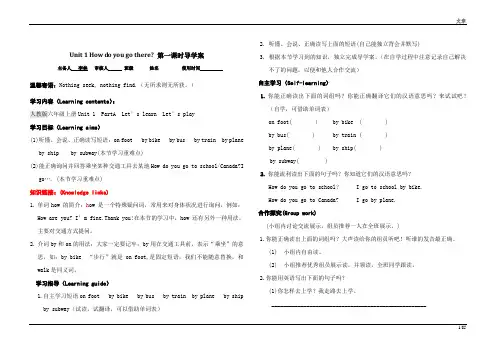
Unit 1 How d o you go there? 第一课时导学案主备人李林审核人班级姓名使用时间温馨寄语:Nothing seek, nothing find.(无所求则无所获。
)学习内容(Learning contents):人教版六年级上册Unit 1 PartA Let’s learn Let’s play学习目标(Learning aims)(1)听懂、会说、正确读写短语:on foot by bike by bus by train by planeby ship by subway(本节学习重难点)(2)能正确询问并回答乘坐某种交通工具去某地How do you go to school/Canada?Igo…. (本节学习重难点)知识链接:(Knowledge links)1.单词how 的简介:h ow 是一个特殊疑问词,常用来对身体状况进行询问,例如:How are you? I’m fine.Thank you!在本节的学习中,how 还有另外一种用法,主要对交通方式提问。
2.介词by和on的用法:大家一定要记牢:by用在交通工具前,表示“乘坐”的意思,如:by bike “步行”就是on foot,是固定短语,我们不能随意替换,和walk是同义词。
学习指导(Learning guide)1.自主学习短语on foot by bike by bus by train by plane by shipby subway(试读,试翻译,可以借助单词表)2. 听懂、会说、正确读写上面的短语(自己能独立背会并默写)3. 根据本节学习到的知识,独立完成导学案。
(在自学过程中注意记录自己解决不了的问题,以便和他人合作交流)自主学习(Self-learning)1.你能正确读出下面的词组吗?你能正确翻译它们的汉语意思吗?来试试吧!(自学,可借助单词表)on foot( ) by bike ( )by bus( ) by train ( )by plane( ) by ship( )by subway( )2.你能流利读出下面的句子吗?你知道它们的汉语意思吗?How do you go to school? I go to school by bike.How do you go to Canada? I go by plane.合作探究(Group work)(小组内讨论交流展示,组员推荐一人在全班展示。
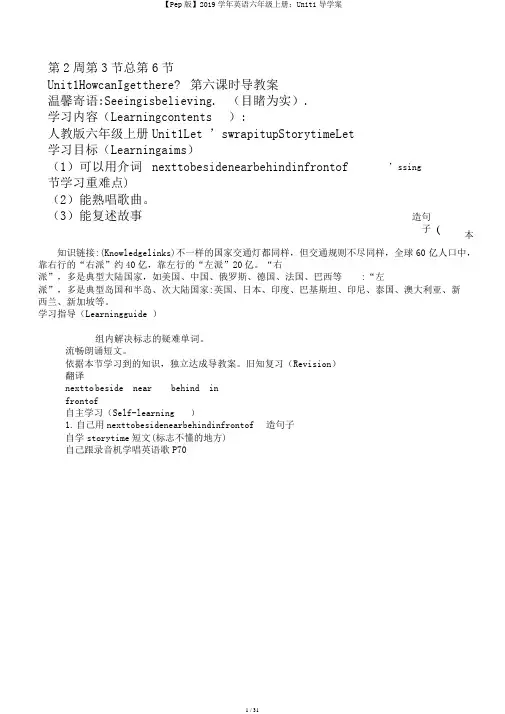
第2周第3节总第6节Unit1HowcanIgetthere? 第六课时导教案温馨寄语:Seeingisbelieving. (目睹为实).学习内容(Learningcontents ):人教版六年级上册Unit1Let ’swrapitupStorytimeLet 学习目标(Learningaims)(1)可以用介词nexttobesidenearbehindinfrontof 节学习重难点)(2)能熟唱歌曲。
(3)能复述故事’ssing造句子(本知识链接:(Knowledgelinks)不一样的国家交通灯都同样,但交通规则不尽同样,全球60亿人口中,靠右行的“右派”约40亿,靠左行的“左派”20亿。
“右派”,多是典型大陆国家,如美国、中国、俄罗斯、德国、法国、巴西等:“左派”,多是典型岛国和半岛、次大陆国家:英国、日本、印度、巴基斯坦、印尼、泰国、澳大利亚、新西兰、新加坡等。
学习指导(Learningguide )组内解决标志的疑难单词。
流畅朗诵短文。
依据本节学习到的知识,独立达成导教案。
旧知复习(Revision)翻译nextto beside near behind infrontof自主学习(Self-learning )1. 自己用nexttobesidenearbehindinfrontof 造句子自学storytime短文(标志不懂的地方)自己跟录音机学唱英语歌P70合作研究(小组内议论沟通展现。
)(Groupwork)1.你能用nexttobesidenearbehindinfrontof造句子吗全班共同解决短文中的疑难问题。
你能流畅朗诵故事吗?高声读给你的组员听吧!你能复述故事吗你能唱英语歌吗小组展现(Groupshow):对合作研究中的问题进行展现。
讲堂小结(Summary)这节课我学会了_________________________________________稳固延长(Consolidationandextension)本单元要点句型:HowcanIgetthere?Turnleft/rightatthehospital.Whereistherestaurant?It’snexttothepostoffice.Let’sgostraight.Whataninterestingfilm!Followme,please.上边的句子你能增补完好吗?你知道它们的汉语意思吗?写一下吧!________________________________________________________________________________________________________________________________________________________________________________________________________________讲堂检测(Test)连词成句。
第1周第1节总第1节Unit 1 How can I get there? 第一课时导学案温馨寄语:Nothing seek, nothing find.(无所求则无所获。
)学习内容(Learning contents):人教版六年级上册Unit 1 Let’s try Let’s talk Let’s learn学习目标(Learning aims)(1)听懂、会说、正确读写短语:in the museum in the bookstore in hospital at the cinemanear the door next to the museum want to buy a postcard(本节学习重难点)(2)能正确询问并回答某地在哪Where is/ar e…?It/They is/are…. (本节学习重难点)知识链接:(Knowledge links)1.单词where 的简介:where 是一个特殊疑问词,常用来对地点询问,例如:Where isthe museum shop? It’s near the door!2.介词in和at的用法:大家一定要记牢:在地点名词前,既可以in,也可以用at。
大地方一般用in,小地方用in at都可以学习指导(Learning guide)1.自主学习短语in the museum in the bookstore near the door next to the museumwant to buy a postcard in the bookstore in hospital at the cinema(试读,试翻译,可以借助单词表)2. 听懂、会说、正确读写上面的短语(自己能独立背会并默写)3. 根据本节学习到的知识,独立完成导学案。
(在自学过程中注意记录自己解决不了的问题,以便和他人合作交流)自主学习(Self-learning)1.你能正确读出下面的词组吗?你能正确翻译它们的汉语意思吗?来试试吧!(自学,可借助单词表)in the museum()in the bookstore ()near the door ()next to the museum()want to buy a postcard()in the bookstore()in hospital ()at the cinema()2.你能流利读出下面的句子吗?你知道它们的汉语意思吗?Where is the museum shop? It’s near the door!Where is the post office? It’s next to museum.合作探究(Group work)(小组内讨论交流展示,组员推荐一人在全班展示。
2019-2020年新版PEP英语六年级上册Unit1Howdoyougothere第四课时导学案(彩图)温馨寄语: No cross, no crown. (不经风雨,怎能见彩虹).学习内容(Studying contents):人教版六年级上册Unit 1B. Let’s learn Let’s play C. Good to know学习目标(Learning aims)(1)听懂、会说、正确读写单词和短语:stop, wait , go, traffic lights, traffic rules,remember, look at (本节学习重难点)(2)能正确理解并能在实际情况中运用Stop at a red light. Wait at a yellow light. Goat a green light. (本节学习重难点)(3)在实际生活中能养成遵守交通规则的好习惯。
知识链接:(Knowledge links)1.look at 看……固定短语,用于引起别人的注意,如:look at the blackboard(看黑板),look at me(看我)…….2.traffic rules 是traffic rule的复数形式,traffic lights是traffic light的复数形式,在实际运用中要正确使用复数。
3.Chant:Red light,red light,stop stop stop;Yellow light,yellow light,wait waitwait;Green light,green light ,go go go.学习指导(Learning guide)1.自主学习单词和短语stop, wait, go , traffic lights, traffic rules, remember,look at(试读,试翻译,可以借助单词表)2.听懂、会说、正确读写上面的短语(自己能独立背会并默写)3.根据本节学习到的知识,独立完成导学案。
课 题 Unit 1 How do you go there? 第一课时 温馨寄语:Nothing seek, nothing find.(无所求则无所获。)
学习目标 (1) 通过预习,小组合作,听录音跟读,认读单词卡片,游戏,机械操练,模仿等活动,听、说、读、写:on foot by bike by bus by train by plane by ship by subway (2)能正确询问并回答乘坐某种交通工具去某地How do you go to school/Canada?I go….
学习重点 通过预习,小组合作,听录音跟读,认读所学单词,发音准确。能正确询问并回答乘坐某种交通工具去某地How do you go to school/Canada?I go….
学习指导 1.自主学习短语on foot by bike by bus by train by plane by ship by subway(试读,试翻译,可以借助单词表) 2. 听懂、会说、正确读写上面的短语(自己能独立背会并默写) 3. 根据本节学习到的知识,独立完成导学案。(在自学过程中注意记录自己解决不了的问题,以便和他人合作交流)
知识链接 1. 单词how 的简介:how 是一个特殊疑问词;2. 常用来对身体状况进行询问;3. 主要对交通方式提问。
合 作 探 究 过 程 二 次 备 课 自主学习(Self-learning)
1. 你能正确读出下面的词组吗?你能正确翻译它们的汉语意思吗?来试试吧!(自学,2. 可借助单词表) on foot( ) by bike ( ) by bus( ) by train ( ) by plane( ) by ship( ) by subway( ) 3. 你能流利读出下面的句子吗?你知道它们的汉语意思吗? How do you go to school? I go to school by bike. How do you go to Canada? I go by plane. 合作探究(Group work) (小组内讨论交流展示,组员推荐一人在全班展示。) 1.你能正确读出上面的词组吗?大声读给你的组员听吧!听谁的发音最正确。 (1)小组内自由读。(2)小组推荐优秀组员展示读;(3)领读、抽查读; (4)全班同学跟读。(5)背诵、抽查拼背。 2.你能用英语写出下面的句子吗? (1)你怎样去上学?我走路去上学。_____________________________ (2)你怎样去公园?我坐公交去。______________________________ 小组展示(Group show) 对合作探究中的两个问题进行展示。 课堂小结(Summary) 这节课我学会了___________________________________________。 巩固延伸(Consolidation and extension) 完成下列表格:
课堂检测(Test) 1.你能根据图片写出正确的短语吗?
_______ __________________ ______ ________ _________ 2.连词成句: (1) do how to you go school ________________________________________ (2) car I to usually school go by _________________________________________
板 书 设 计
教 学 反 思
课 题 Unit 1 How do you go there? 第二课时 温馨寄语:No pain,no gain.(不劳无获。) 学习目标 1. 通过实际问答、情境理解、小组对话、师生活动等听懂、会说、流利读、正确书写四会句子:“How do you go to school? Usually I go to school on foot.Sometimes I go by bike.” 2.能够听懂Let's try的录音内容并选出正确选项 3. 通过小组反复操练,师生对话,生生对话,限时背默,趣味游戏等活动,能够听说读写本单元A、B部分的Let’s talk中四会句型,并能让80%的学生运用所学句型表述自己以何种方式上学并简单陈述原因,如:Usually I go to school by bus,because it's fast.
学习重点 能听懂、会说、流利读、正确书写四会句子:“How do you go to school? Usually I go to school on foot.Sometimes I go by bike.”
学习指导 1.自主学习对话(试读试翻译,可以借助单词表,不会的注意作标记) 2.流利背诵对话。(自己能独立背并默写重点句型) 3.根据本节学习到的知识,独立完成导学案。
知识链接 1. 频率副词:usually(通常,2. 一般)、always(总是)、often(经常)、sometimes(有时候)、never(从不 ) 3. 一般现在时:表示现在经常反复发生的动作、存在的状态或习惯性的动作的时态。
合 作 探 究 过 程 二 次 备 课 旧知复习(Revision)
看图写词。
_____ __________________ ______ ________ _________ 自主学习(Self-learning) 1. 你能完成听音圈图的练习吗?
2. 你能正确读出下面的句子吗?你能正确翻译它们的汉语意思吗?来试试
吧!(自学,3. 可同4. 桌交流) How do you go to school? Usually I go to school on foot. Sometimes I go by bike. 合作探究(Group work) (小组内讨论交流展示,组员推荐一人在全班展示。) 1.你能流利朗读对话吗?大声读给你的组员听吧!听谁的发音最正确。 (1)小组内自由读。 (2)各小组长领读,全班跟读。 (3)小组推荐优秀组员分角色表演。 2.你能用英语写出下面的句子吗? (1)你怎样去上学?通常我走路去上学。 _____________________________________________________ (2)有时候我骑自行车去。 ____________________________________________________ 小组展示(Group show) 对合作探究中的两个问题进行展示。 课堂小结(Summary) 这节课我学会了___________________________________________ 巩固延伸(Consolidation and extension) 1. 看图仿写对话(课本第五页)。 2. 组内展示所写对话。 3. 小组交流,4. 完成Group work. 课堂检测(Test) 一.连词成句。 1.I how get can to Zhongshan Park(?) ________________________________________ 2.go I foot can on(?)_______________________ 二.改错,并纠正。 1.How do you go school? _______→_______ 2.I go to home by bike. _______→_______ 3.I usually go to school by foot. _______→_______ 4.I go to the USA by bus. _______→_______ 5.Do you go on bike? _______→_______
板 书 设 计
教 学 反 思
课 题 Unit 1 How do you go there? 第三课时 温馨寄语:Practice makes perfect.(实践出真知)
学习目标 (1)通过前置预习,创设情景,情景对话,小组合作,带问题独立阅读,理解并能听说并流利朗读Let's read部分的内容,并能独立完成文后的问题。 (2)通过听音、模仿、比较、总结、举例、观察等活动,让80%的学生了解音标元音/i:/,/i/和辅音/p/, /b/, /t/, /d/的读音,并会朗读例词,完成连线部分。 学习重点 通过听音、模仿、比较、总结、举例、观察等活动,让80%的学生了解音标元音/i:/,/i/和辅音/p/, /b/, /t/, /d/的读音,并会朗读例词,完成连线部分。
学习指导 1.自主学习短文(试读试翻译,画出词组,可以借助单词表,不理解的作标记)。 2.组内解决标记的疑难单词。 3.流利朗读对话。(自己能独立完成短文后的习题) 4.自主学习语音。(不会的向老师请教) 5.根据本节学习到的知识,独立完成导学案。
知识链接 1.在具体时间前用介词at,如:at 2o’clock. 2.fifth是five的序数词。 3.floor有两个意思,一个是“地板”,另一个是“层,楼”。 4.情态动词can后用动词原形。
合 作 探 究 过 程 二 次 备 课 旧知复习(Revision)
复习背诵上节课学过的对话(小组集体背诵)。 自主学习(Self-learning) 1.你能正确读出下面的句子吗?你能正确翻译它们的汉语意思吗?来试试吧!(自学,可同桌交流) How do we go to the park? We can go to the bus stop on foot. Then we go to the park by bus. Where is your home? My home is near the post office. Which floor? The fifth floor. See you then. 2.你能找出短文中的词组吗?请写下来。 ___________________________________________________________ ___________________________________________________________ 3.我们学过的单词中有哪些符合下列条件,请写出来: ea |i:| _____________________________________________ i |i| _____________________________________________ 合作探究(Group work) (小组内讨论交流展示。)